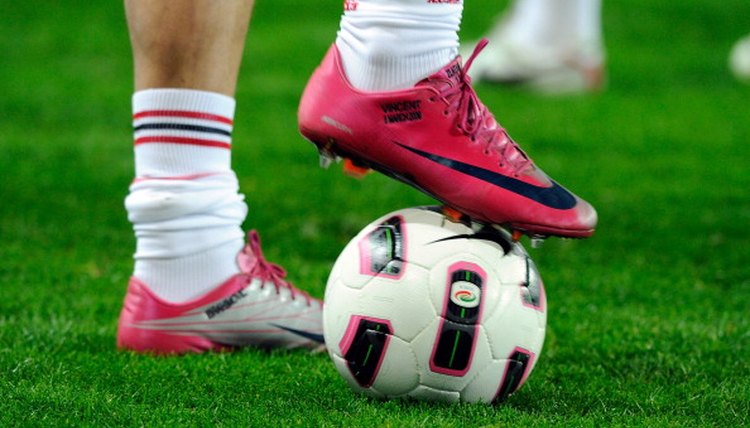Difference Between Soccer & Lacrosse Cleats

Cleated shoes give you the potential to dig your heels or the front of your foot into a grassy playing field and zoom in any direction. Along with baseball, football, and track and field, both lacrosse and soccer are sports played with cleats, meaning shoes with studs. Especially if you live in the Northeast of the U.S., where both soccer and lacrosse have established strongholds, you may need to know how the cleats differ.
Ankle Support
The main difference between the two types of cleats lies in the extent to which they support your ankles. Lacrosse cleats are cut higher to offer greater support to the ankle, while soccer cleats offer a low cut to save weight and permit easier changes of direction. Lacrosse cleats offer you a choice of a three-quarter or mid-top shoe. Because of the need for ankle support for lacrosse, trainers recommend staying away from low-cut shoes, note the authors of “Lacrosse: The Player’s Handbook.” Coach Jamey Long of SimplyLacrosse.com says he personally prefers the extra ankle support of a high-top or mid-top shoe. Since higher-topped shoes are heavier and more restrictive, you may want a lower-cut lacrosse cleat if you are a faster player, he adds.
History
From the late 19th century through the beginning of the 1950s, soccer cleats resembled lacrosse cleats. They provided a high cut for ankle support, as they were essentially converted everyday boots. Germany-based Adidas led the way in converting soccer cleats to a more slipper-like profile as Germany, Hungary and other teams copied Brazil’s playing style, reliant on speed and a light touch on the ball.
Weight
If football cleats are the heaviest and track and field the lightest cleats in weight, soccer and lacrosse fall in the middle of the spectrum -- with lacrosse shoes a bit heavier given the extra material higher on the ankle. The weights are close enough to allow you to wear soccer shoes to play lacrosse, note Noah Fink and Melissa Gaskill in “Lacrosse: A Guide for Parents and Players.”
Cleat Pattern and Stud Length
Both cleats typically have four studs in the heel area and six to eight in the forefoot. Soccer cleats, however, have no stud at the end of the toe, while lacrosse cleats do. Lacrosse studs by rule cannot be longer than a half-inch, states “The Confident Coach's Guide to Teaching Lacrosse." Soccer studs range typically from 12 to 16 mm -- about the same length, a half-inch. Neither sport allows metal cleats such as those used by baseball players. Cleats for both sports can have molded outsoles or in more expensive models, the studs can be replaced and a different length screwed in depending on field conditions.
Available Types
Manufacturers make women-specific soccer shoes but not women-specific lacrosse cleats. For either lacrosse or soccer, you can wear turf shoes on artificial outdoor surfaces. Turf shoes feature short nubs that don’t tear up the surface.
References
Writer Bio
An award-winning writer and editor, Rogue Parrish has worked at the Washington Post, the Baltimore Sun and at newspapers from England to Alaska. This world adventurer and travel book author, who graduates summa cum laude in journalism from the University of Maryland, specializes in travel and food -- as well as sports and fitness. She's also a property manager and writes on DIY projects.
